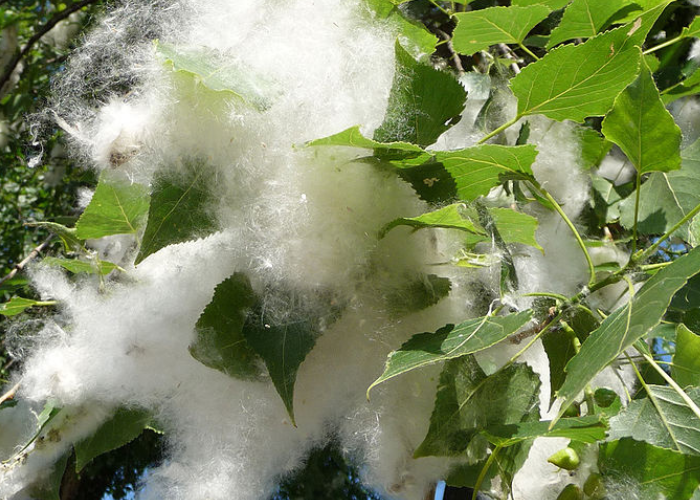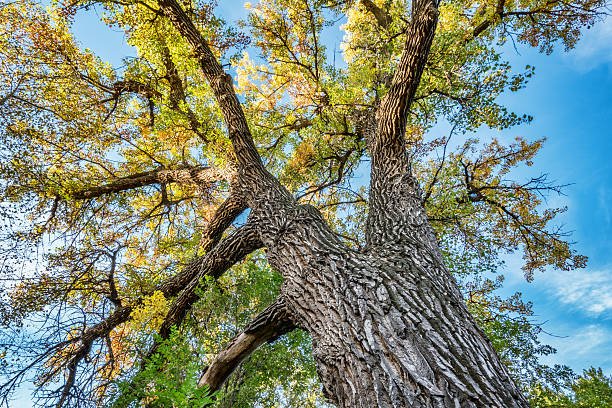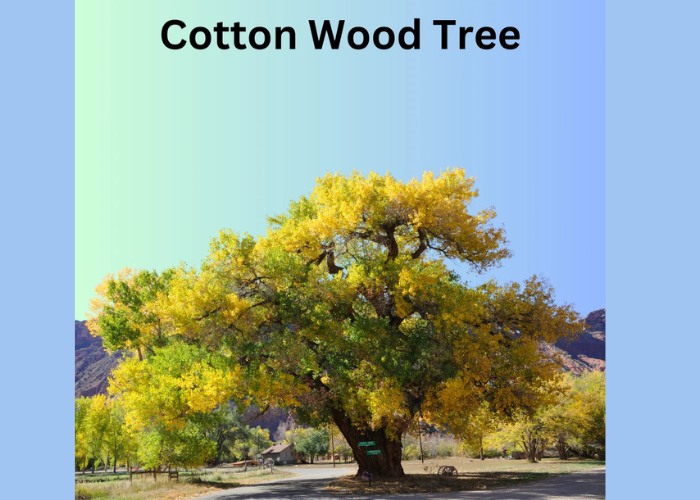Cotton wood
Cotton woods are fast-growing trees native to North America, Europe, and western Asia that belong to the genus Populus in the family Salicaceae. They are known for their triangular, toothed leaves and cottony seeds that drift in the wind.
Populus sect. Aigeiros
Species count : Three recognized species, formerly up to six
Cotton wood Scientific name: Populus
Native regions : North America, Europe, and western Asia
Physical characteristics:
Large, deciduous trees up to 30 m tall, with thick bark and triangular or diamond-shaped leaves.
Common species of cotton wood trees
Eastern Cotton wood (Populus deltoides)
- Originally from North America, these trees grow all across the eastern, central, and southwestern parts of the United States.
- Large, fast-growing tree reaching heights of 50-100 feet
- Triangular leaves with coarsely toothed margins
- Important for wildlife and historically used by Native Americans and settlers.
Black Cotton wood (Populus trichocarpa)
- These trees are native to western North America, spanning from Alaska to California.
- Largest of the cottonwoods, growing up to 60 meters tall
- Oval-shaped leaves and high growth rate
- Important for wildlife habitat and used for timber and pulp.
Fremont Cotton wood (Populus fremontii)
- These trees are native to the southwestern United States and western Mexico.
- Similar to eastern cotton wood but with larger, fewer leaves
- Thrives in riparian zones and floodplains
- Used for shade and construction material.
Plains Cotton wood (Populus deltoides var. occidentalis)
- These trees are found in the Great Plains region of the United States.
- Adapted to plains environment
- State tree of Wyoming
- Historically important for early settlers in the Great Plains.
Narrowleaf Cotton wood (Populus angustifolia)
- Native to western North America
- Grows to heights of 30-50 feet with a spread of 20-30 feet
- Has long, narrow, willow-like leaves
- Often found along creeks and in riparian areas.
Cotton woods are widely grown for timber, screens, and shelterbelts. The wood is coarse but strong, used for pallets, crates, and other purposes. They are also a favorite medium for artisans to carve.
These trees typically live 70-100 years but can reach 200-400 years old in ideal conditions. The oldest recorded eastern cotton wood was the Balmville Tree in New York, felled in 2015 at approximately 316 years old.
Also read: Why Alder Wood is Ideal choice for Your Next DIY Project !
Characteristics of Cottonwood Trees

Physical Characteristics
Height and Growth: Cotton wood trees are known for their rapid growth, often adding 6 feet or more in height each year. Mature trees can reach heights of 70-100 feet, with some species growing up to 150 feet tall
Leaves: The leaves are typically broad and triangular with coarsely toothed edges. They are dark green and glossy on the upper side and paler underneath. The leaves are attached to flattened petioles, which allow them to flutter in the wind
Bark: The bark of young cotton woods is smooth and yellowish-green, becoming gray and deeply furrowed as the tree matures
Branches: Cottonwoods have a wide, spreading branch structure that adds architectural interest, especially in winter.
Reproduction
Dioecious Nature: These woods are dioecious, meaning male and female flowers grow on separate trees. The flowers are catkins, with male catkins being reddish-purple and female catkins green. Female trees produce cottony seeds that disperse in the wind
Seed Production: A single cottonwood tree can release up to 40 million seeds in a season. The seeds are attached to cotton-like strands, which help them travel long distances
Habitat and Ecology
Preferred Environment: Cottonwoods thrive in moist areas, often found along rivers, streams, and floodplains. They prefer full sun and sandy or silty soil
Ecological Role: They provide important habitat for wildlife, including nesting sites for birds and food for various animals. They play a crucial role in riparian ecosystems by stabilizing soil and providing shade.
Uses
Cotton wood trees have a variety of important uses and benefits:
Ecological importance:
- Provide habitat and food for wildlife, especially birds and insects
- Help stabilize riverbanks and prevent erosion
- Offer shade and cooling effects in riparian areas
Wood products:
- Used for making furniture, especially shelving and interior pieces
- Good for crates, pallets, and packing materials
- Pulped for paper production
- Used for plywood, oriented strand board (OSB), and other engineered wood products
- Suitable for carving and whittling
Traditional and historical uses:
- Native Americans used cottonwood for dugout canoes, ceremonial objects, and medicinal purposes
- Early American settlers used it for building materials, fuel, and animal fodder
- The trees served as landmarks and trail markers for pioneers
Medicinal and herbal uses:
- Cotton wood buds contain salicin, which has anti-inflammatory properties similar to aspirin
- Used to make balms and salves for pain relief, wound healing, and skin conditions
- Inner bark has been used for herbal teas and as a nutritional supplement
Other practical uses:
- Bark can be used to make rope
- Wood is good for smoking meats and leather
- Leaves and young branches can be used as animal feed
- Resin from buds can be used as a natural glue
Artistic and cultural significance:
- Used for carving kachina dolls, masks, and other ceremonial objects by some Native American tribes
- Featured in various Native American legends and stories
- Appreciated for its aesthetic value in landscapes
While cotton wood is sometimes considered a “junk” wood due to its softness and tendency to warp, it has many valuable uses when properly harvested and utilized. Its rapid growth and adaptability to various environments make it an important tree species both ecologically and economically.

Challenges:
Messiness: These woods can be messy trees due to their cottony seed production and tendency to drop branches
Lifespan: They are relatively short-lived trees, typically living 70-100 years, though some can live 200-400 years in ideal conditions.
Pests and Diseases: Cottonwoods are prone to certain diseases and pests, which can limit their lifespan in urban settings.
Interesting Facts
Historical Use: General Custer fed his horses and mules the bark during the 1868–69 winter campaign against Native American tribes. Cowboys made an astringent tea from the inner bark to treat gastric disorders.
Environmental Benefits: Cotton woods have been shown to be effective in phytoremediation, helping to clean up contaminated groundwater
Are there any medicinal uses for cottonwood bark ?
Pain relief: Cotton wood bark contains salicin, a compound that breaks down into salicylic acid in the body, which has pain-relieving and anti-inflammatory properties similar to aspirin. It has been used traditionally to treat various types of pain, including arthritis, muscle aches, and headaches.
Fever reduction: The salicin in these wood bark also has febrifuge properties, meaning it can help reduce fevers.
Respiratory support: Cotton wood bark has expectorant properties, which can help break up and expel mucus, making it useful for respiratory conditions like coughs and bronchitis.
Wound healing: The bark has antiseptic and antimicrobial properties that can aid in wound healing and prevent infection.
Skin conditions: Cotton wood bark can be used topically to soothe and heal various skin conditions, including eczema, psoriasis, and minor burns.
Digestive issues: Some Native American tribes used these wood’s bark to treat digestive problems.
Urinary tract support: Cottonwood bark has diuretic properties, which can be beneficial for urinary tract health.
Traditionally, cotton wood bark has been used in various forms, including:
- Teas or infusions
- Tinctures
- Salves or ointments for topical application
- Powdered form for internal use or as a poultice.
FAQ
1. What are cotton wood trees?
Cottonwood trees are large deciduous trees belonging to the genus Populus. They are known for their fast growth and large, broad leaves that often have a distinctive cotton-like texture.
2. Where are cotton wood trees found?
Cottonwood trees are native to North America and can be found throughout the continent, typically growing near rivers, streams, and other bodies of water.
3. How tall do cotton wood trees grow?
Cottonwood trees can grow quite tall, often reaching heights between 50 to 100 feet (15 to 30 meters) or even taller under optimal conditions.
4. What do cotton wood tree leaves look like?
Cottonwood leaves are broadly triangular with serrated edges. They are usually bright green in color and can turn yellow in the fall before dropping.
5. Do cotton wood trees produce cotton?
Yes, cottonwood trees produce cotton-like seeds that are surrounded by fluffy fibers. These fibers help the seeds disperse on the wind.
6. Are cotton wood trees good for landscaping?
Cottonwood trees can be suitable for large-scale landscaping in areas where their rapid growth and shade-providing canopy are desired. However, they can be messy due to shedding leaves and cotton-like seeds.
7. Do cotton wood trees have any special ecological importance?
Yes, it plays a crucial role in riparian ecosystems. Their presence stabilizes riverbanks, provides habitat for wildlife, and their leaves contribute to nutrient cycling in aquatic environments.
8. Are cottonwood trees prone to any diseases or pests?
Cottonwood trees can be susceptible to various pests and diseases, including leaf spot diseases, canker diseases, and pests like cottonwood borers and aphids.
9. Can cotton wood trees be planted near homes?
Planting cottonwood trees near homes should be done with caution due to their size and potential for dropping branches. They are better suited for large open spaces away from structures.
Also read: Ash Wood: Discover Its Secrets!

